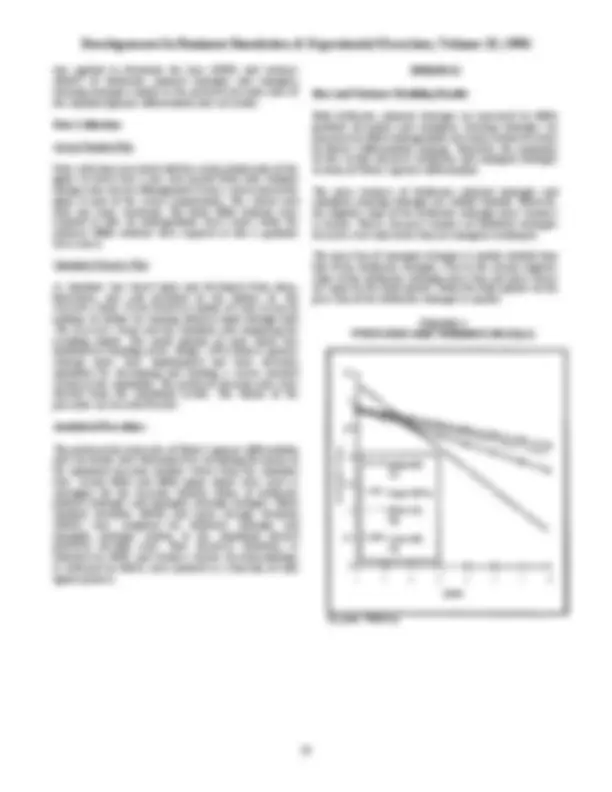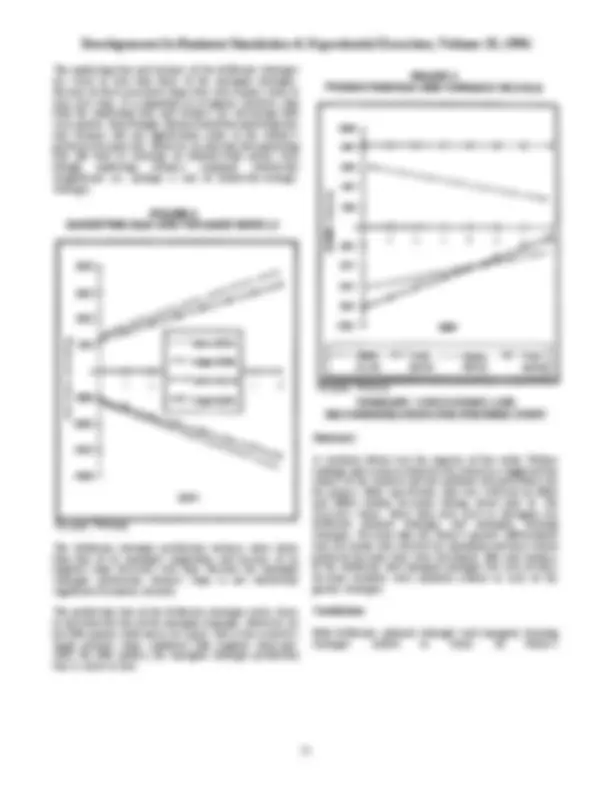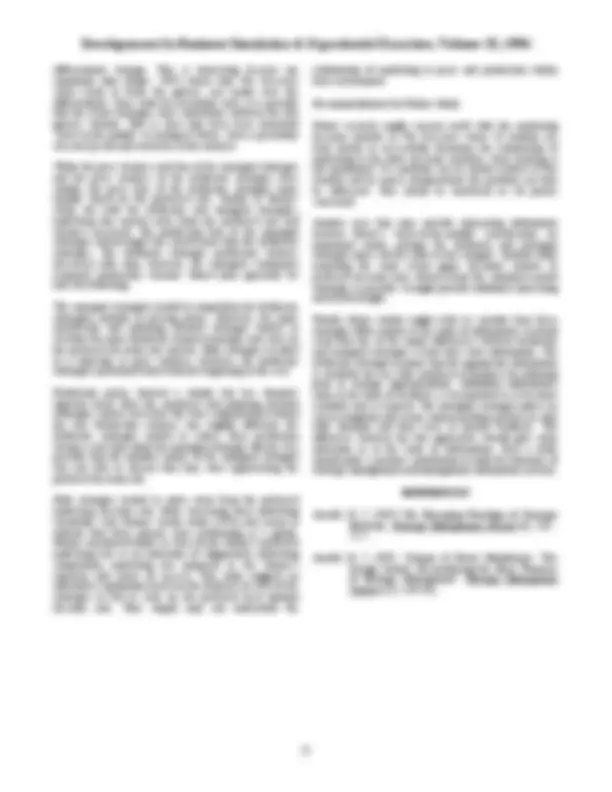





Study with the several resources on Docsity

Earn points by helping other students or get them with a premium plan


Prepare for your exams
Study with the several resources on Docsity

Earn points to download
Earn points by helping other students or get them with a premium plan
Community
Ask the community for help and clear up your study doubts
Discover the best universities in your country according to Docsity users
Free resources
Download our free guides on studying techniques, anxiety management strategies, and thesis advice from Docsity tutors
This study is a response to a scholarly debate that took place in the Strategic Management Journal between Henry. Mintzberg (1990, 1991) and Igor Ansoff ...
Typology: Study notes
1 / 6

This page cannot be seen from the preview
Don't miss anything!




An Analysis of Deliberate and Emergent Strategies Relative to Porter’s Generic Differentiator and Cost Leader: A Bias and Variance Modeling Approach
Joseph N. Roger, Northeastern State University
Background
This study is a response to a scholarly debate that took place in the Strategic Management Journal between Henry Mintzberg (1990, 1991) and Igor Ansoff (1991) concerning their theories of emergent versus deliberate strategies. Prior to the debate, Mintzberg and Waters (1985) indicated an interest in knowing whether “... cost leadership strategies might prove more deliberate (specifically, more often planned) ..“ or “... differentiation strategies more emergent.” Therefore this study considers how deliberate and emergent strategies relate to Porter’s (1985) generic differentiator and cost leader.
Chronological Overview of the Debate
Henry Mintzberg (1990) began the debate with a discussion and critique of the ‘design school’ generally associated with the Business Policy group at the Harvard Business School. Igor Ansoff (1991) countered with a defense of the ‘design school’ and a discussion and critique of Mintzberg’s ‘emerging strategy’ school.
The next communication, from Mintzberg (1991), responds to Ansoff by categorizing his work as being from the ‘planning school’ and suggesting that it was built upon the basic premises of the design school (Andrews, 1987). Although he does permit that both emergent learning and deliberate planning have a place in strategic management, all the while, he staunchly defends his initial position.
Finally Michael Goold (1992), elaborates upon (and defends his and BCG’s role in) Mintzberg’s (1991) account of Honda’s development of a successful motorcycle strategy. He acknowledges differences between the planning and learning approach but counsels that synthesis and collaboration, rather than conflict, are most appropriate for the continued development of the discipline.
Purpose of the Study
Rather than letting an interesting academic exchange die, this study adds to the literature by empirically analyzing surrogates of deliberate, planned strategies and emergent, learning strategies. These strategy types are considered
relative to Porter’s generic differentiator and cost leader within the confines of a controlled business simulation through the use of Bowman’s managerial coefficient. The intent is not to produce conflict; instead, it is to seek the truth.
The Elements
The Design School.
The design school and its derivative, the planning school, are represented here by Andrews and Ansoff respectively. Mintzberg’s bone of contention seems to lie at the heart of these two schools. Specifically related to the current debate, these schools promote strategy formulation based on planning and analysis prior to implementation (Mintzberg, 1990). However, the design school does recognize that some revisions to the original strategy may be required due to and guided by operational feedback (Andrews, 1987).
The Learning School.
The learning school is represented here by Mintzberg. He contends that the schools discussed above incorrectly promote strategy formulation as a matter of conception. Instead, Mintzberg sees strategy formulation as an emergent process of trial and error that takes place during implementation (Mintzberg, 1990).
He does allow that “... we shall get nowhere without emergent learning alongside deliberate planning”. Here he compares learning and planning to “two feet walking”, one following the other, along the path to an emerging strategy (Mintzberg, 1991). In essence he seems to be saying that strategy is definitely emergent but that planning and analysis do play a part in its formation.
Business Simulation.
Today’s business simulation is a theoretical model of an industry represented by a program run on a microcomputer. The mathematical formulas that represent the relationships between the decision variables available to the various competitors and the outcome of the interaction of those variables due to participant decision is an integral part of the intended experiential learning environment.
The total experience that the game model strives to project is largely responsible for much of the competitive spirit manifest during play (Meier, Newell, and Pazer, 1969). This competitive spirit lends itself to high levels of motivation and prompts many students to actively seek out ways to understand the game model. The typical student reaction, according to Fulmer (1963), is for the student to
recall theoretical principles and timidly at first, then boldly, put them to work in reaching a group of decisions. They grasp, as a sinking man, the flitting analytical techniques from accounting and statistics which at one time had been brushed aside as so- much drudgery, and at best a dull routine.
However, not all students have similar educational backgrounds. Some have been exposed to more techniques and theories relating to the functional areas of business than have others. It is only reasonable to expect differences in play between students who have been exposed to specific analytical techniques within the general concept of business planning and those who have not experienced these ideas. Two groups in which such differences are likely to occur are BBAs and MBAs.
The Surrogates.
Hemmasi, Graf, and Kellogg (1989) studied MBA and BBA students involved in the play of a business game. They found that MBA groups were more systematic and analytical than intuitive. Conversely, BBA groups were found to be more intuitive than systematic and analytical. These findings are not surprising in the light of the previous discussion relative to the possible differences between student groups. Therefore, theory leads to a prediction that MBA students tend to be characterized by a more systematic and analytical style of play and that BBA students tend to be characterized by a more intuitive style of play.
Of course it is not being suggested that undergraduates students do not plan; nor is it being suggested that graduate students do not learn by trial-and-error. What is being suggested is that graduates tend toward the deliberate end of the continuum while undergraduates tend toward the emergent end of the continuum. For these reasons, MBA and BBA students were selected as surrogates for the deliberate planned school and the emergent, learning school respectively. The characteristics of the members of each set seem to match well.
Bowman’s Managerial Coefficient and Simulation.
Bowman’s managerial coefficient theory is based on the manager’s use of decision rules. Mean absolute deviation (MAD) from the preferred rule is termed variance and associated with erratic decision making. Mean signed deviation (MSD) from the preferred rule is termed bias and associated with incorrect intuition (Bowman, 1963). Remus (1978) demonstrated the aptness of Bowman’s managerial coefficient theory in The Executive Game (Henshaw and Jackson, 1972).
In previous studies, conducted in environments that supported mathematical optimization, preferred decision rules were determined through the use of differential calculus. Because no mathematically optimal solutions to The Executive Game exist, the game winners decisions were taken by Remus (1978) as the preferred decision rule. Player learning, as measured by a reduction in erratic decision making (variance) and incorrect intuition (bias), was determined to be consistent with oligopolistic theory. (Remus, 1978)
This study also uses The Executive Game; however, simulation coupled with a search-oriented system (Roge’,
METHODOLOGY
Overview of the Experiment
The Executive Game, a widely recognized general management game, was used in this study as a vehicle to empirically analyze deliberate, planned strategies and emergent, learning strategies within the confines of a controlled business game. Student decisions were collected from actual play of the game within the context of required coursework. Additionally, a simulation of the game, supported by a search oriented system, was used to develop locally optimized decisions for a balanced set of strategies.
The values of the relevant optimized decision variables were then used to develop the preferred decision rules for Porter’s generic differentiator and cost leader strategies. The preferred decision rules provided a standard against which to judge the actual student decisions that were collected earlier. Specifically, Bowman’s managerial coefficient theory
The marketing bias and variance of the deliberate strategies are closer to zero than those of the emergent strategies. Because of their associated slopes they also remain closer to zero over time. It is important to recognize, however, that both the marketing bias and variance are increasing with each quarter. Interestingly, Remus found that marketing bias and variance did not significantly relate to the winner’s preferred decision rule. However, he did note that marketing bias did tend to converge on industry-wide policy even though marketing variance remained statistically insignificant (i.e. perhaps a sort of follow-the-average- strategy).
The deliberate strategies production variance starts lower than that of its emergent competitors and because of its negative slope decreases over time. Because the emergent strategies production variance slope is not statistically significant it remains constant.
The production bias of the deliberate strategies starts closer to zero than the bias of the emergent strategies. However, by the fifth quarter, both biases are equal. This is the result of a larger positive slope combined with negative intercepts. After the fifth quarter, the emergent strategies production bias is closer to zero.
Summary
A scholarly debate was the impetus of this study. Further readings and research related to the references suggested the subject of the analysis and the methods and procedures for the project. More specifically, data was collected on BBA and MBA student decisions during actual play of The Executive Game. These data were used as surrogates for deliberate planned strategies and emergent, learning strategies. Decision data for Porter’s generic differentiator and cost leader were derived by simulation and their related preferred decision rules were developed. Bias and variance of the deliberate and emergent strategies for each of three decision variables were modeled relative to each of the generic strategies.
Conclusions
Both deliberate, planned strategies and emergent, learning strategies tended to better fit Porter’s
differentiator strategy. This is interesting because me simulation data (Roge’, 1995) shows that The Executive Game tends to favor the generic cost leader over the differentiator. Since both fit reasonably well, it is possible that the actual strategies were somewhere between the two generic variants. That is, they may have been somewhat ‘stuck-in-the-middle’ according to Porter. Such a possibility was not specifically tested for in this analysis.
While the price variance and bias of the emergent strategies and the price variance of the deliberate strategies were similar, the price bias of the deliberate strategies more rapidly closed on the preferred rule. Similar to Remus’ study, for both the deliberate and emergent strategies, marketing bias moved away from the preferred rule and variance increased. The production bias of the emergent strategies started larger but closed faster than the deliberate strategies. The deliberate strategies production variance decreased with time; however, the emergent counterpart remained statistically constant. Stated more generally we note the following.
The emergent strategists tended to outperform the deliberate strategists initially in pricing policy. However, the more analytically and planning oriented strategies tended to overtake the more intuitively oriented strategies and close on the preferred decision rule quickly. Both strategies resulted in a reduction in price variance; however, the deliberate strategists performed better from the beginning in this case.
Production policy showed a similar but less dramatic opposite trend. Here the analytical and planning oriented strategists started out better but were outperformed toward the end. Production variance was slightly different; the deliberate strategies tended to reduce their production variance over time while the emergent strategies did not. It is possible that the intuitive nature of the emergent strategist was not able to discern that they were approaching the preferred decision rule.
Both strategies tended to move away from the preferred marketing decision rule while increasing their marketing variability. Like Remus’ earlier study (1978), this seems to indicate that these players were performing as a group. Remus considered failure to close on the winner’s preferred marketing rule as an indication of oligopolistic marketing competition; marketing was proposed as the winner’s expertise and source of success. This study suggests an alternative explanation based on the tendency of each of the strategies to fail to close on the preferred local optimal decision rule. They simply may not understand the
relationship of marketing to price and production within their environment.
Recommendations for Further Study
Future research might concern itself with the marketing decision variable in The Executive Game. If students are truly unable to successfully determine the relationship of marketing to the other decision variables, their learning is not maximized. If a problem can be shown relative to this variable and its source demonstrated, the problem can then be addressed. This would be beneficial to all parties concerned.
Another area that may provide interesting information involves Porter’s ‘stuck-in-the-middle’ classification. As mentioned earlier, perhaps the deliberate and emergent strategies more closely relate to this category. Another study analyzing the same actual game decisions relative to preferred decision rules derived from the simulated mixed strategies is possible. It might provide additional interesting and useful insight.
Finally, future studies might wish to consider how these strategies differ relative to the value of information. It would seem that one of the major differences between deliberate and emergent strategies is how they view information. The deliberate strategist assumes that the appropriate information is available for use with analytical techniques for planning prior to strategy implementation. Additional information, some in the form of feedback, is incorporated as it becomes available and is required. The emergent strategist makes no such assumption and seems content (perhaps prefers) to start with intuition and then react to mostly feedback. The difference between the two approaches should give some indication as to the value of information. Such a study should make a positive contribution to both the literature of strategic management and management information systems.
Ansoff, H. I. (1987) The Emerging Paradigm of Strategic Behavior. Strategic Management Journal (8): 501 - 51 5.
Ansoff, H. I. (1991. Critique of Henry Mintzberg’s ‘The Design School: Reconsidering the Basic Premises of Strategic Management’. Strategic Management Journal (12): 449-461.